Potentials of Renewable Energy Sources in Germany and the Influence of Land Use Datasets
Abstract
:1. Introduction
2. Renewable Energy Potentials on Open Spaces
2.1. Land Eligibility Analysis
2.2. Evaluation of Land Use Datasets
- Basis-DLM [12]: Official German dataset with a high positional accuracy (between ±3 and ±15 depending on the feature).
- Corine Land Cover (CLC) [13]: Land cover raster dataset with 100 × 100 resolution. Available as a vector-representation, which is used in this section.
- Open Street Map (OSM) [14]: User-based land-cover vector dataset.
- World Database on Protected Areas (WDPA) [15]: Vector dataset with information on protected areas.
2.3. Onshore Wind Potential
2.3.1. Literature
2.3.2. Methodology
- S1 Legislation: The exclusions are defined according to the laws of Germany’s federal states based on [44] and own corrections.
- S2 Expansive: Wind expansion favoring exclusions including forests and protected landscapes;S2a No Protected Landscapes: S2, excluding protected landscapes;S2b No Forests: S2, excluding forests.
- S3 Restrictive: Restrictive exclusions.
2.3.3. Results & Discussion
2.4. Offshore Wind Potential
2.4.1. Literature
2.4.2. Methodology
- S1 Expansive: Greenfield analyses with offshore wind expansion favoring exclusionsS1a Military: S1, including the usage of military areas.
- S2 Legislation: Current priority and reservation areas for offshore wind in legislation.
- S3 Restrictive Legislation: Current priority areas for offshore wind in legislation.
2.4.3. Results & Discussion
2.5. Open-Field Photovoltaic Potential
2.5.1. Literature
2.5.2. Methodology
2.5.3. Results & Discussion
3. Rooftop Photovoltaic Potential
3.1. Literature
3.2. Methodology
- All roofs
- No northern roofs: Exclusion of north facing groups (N,NW,NE)
3.3. Results & Discussion
4. Discussion
5. Conclusions
Supplementary Materials
Author Contributions
Funding
Data Availability Statement
Conflicts of Interest
References
- United Nations. Paris Agreement; Technical Report; United Nations: Paris, France, 2015. [Google Scholar]
- Die Bundesregierung. Bundes-Klimaschutzgesetz (KSG). 2021. Available online: https://dserver.bundestag.de/btd/19/302/1930230.pdf (accessed on 17 July 2022).
- Stolten, D.; Markewitz, P.; Schöb, T.; Kotzur, L. Strategien für eine Treibhausgasneutrale Energieversorgung bis zum Jahr 2045. (Kurzfassung); Technical Report; Forschungszentrum Jülich GmbH: Jülich, Germany, 2021. [Google Scholar]
- Luderer, G.; Kost, C.; Sörgel, D. Deutschland auf dem Weg zur Klimaneutralität 2045—Szenarien und Pfade im Modellvergleich; Technical Report; Artwork Size: 359 pages; Potsdam Institute for Climate Impact Research: Potsdam, Germany, 2021. [Google Scholar]
- Brandes, J.; Haun, M.; Wrede, D.; Jürgens, P.; Kost, C.; Henning, H.M.; Henning, H.M.; Henning, H.M. Wege zu einem klimaneutralen Energiesystem—Die deutsche Energiewende im Kontext gesellschaftlicher Verhaltensweisen—Update November 2021: Klimaneutralität 2045; Technical Report; Fraunhofer-Institut für Solare Energiesysteme IS: Freiburg, Germany, 2021. [Google Scholar]
- Kendziorski, M.; Göke, L.; Kemfert, C.; von Hirschhausen, C.R.; Zozmann, E. 100% erneuerbare Energie für Deutschland unter besonderer Berücksichtigung von Dezentralität und räumlicher Verbrauchsnähe–Potenziale, Szenarien und Auswirkungen auf Netzinfrastrukturen; Technical Report; Deutsches Institut für Wirtschaftsforschung: Berlin, Germany, 2021. [Google Scholar]
- Prognos; Öko-Insitut; Wuppertal-Institut. Klimaneutrales Deutschland 2045 Wie Deutschland seine Klimaziele schon vor 2050 erreichen kann; Technical Report; Agora Energiewende und Agora Verkehrswende: Berlin, Germany, 2021. [Google Scholar]
- Fette, M.; Brandstätt, C.; Gils, H.C.; Gardian, H.; Pregger, T.; Schaffert, J.; Tali, E.; Brücken, N. Multi-Sektor-Kopplung—Modellbasierte Analyse der Integration erneuerbarer Stromerzeugung durch die Kopplung der Stromversorgung mit dem Wärme-, Gas- und Verkehrssektor; Technical Report; Fraunhofer-Institut für Fertigungstechnik und Angewandte Materialforschung IFAM, Deutsches Zentrum für Luft- und Raumfahrt e.V. (DLR), Gas- und Wärme-Institut Essen e.V.: Bremen, Germany, 2020. [Google Scholar]
- Göke, L.; Kemfert, C.; Kendziorski, M.; Hirschhausen, C.V. 100 Prozent erneuerbare Energien für Deutschland: Koordinierte Ausbauplanung notwendig; Technical Report; DIW—Deutsches Institut für Wirtschaftsforschung: Berlin, Germany, 2021; Version Number: 2.0. [Google Scholar]
- McKenna, R.; Pfenninger, S.; Heinrichs, H.; Schmidt, J.; Staffell, I.; Bauer, C.; Gruber, K.; Hahmann, A.N.; Jansen, M.; Klingler, M.; et al. High-resolution large-scale onshore wind energy assessments: A review of potential definitions, methodologies and future research needs. Renew. Energy 2022, 182, 659–684. [Google Scholar] [CrossRef]
- Ryberg, D.; Robinius, M.; Stolten, D. Evaluating Land Eligibility Constraints of Renewable Energy Sources in Europe. Energies 2018, 11, 1246. [Google Scholar] [CrossRef] [Green Version]
- Geobasisdaten: © GeoBasis-DE / BKG (2021). Digitales Basis-Landschaftsmodell (Ebenen) (Basis-DLM). 2021. Available online: https://gdz.bkg.bund.de/index.php/default/digitales-basis-landschaftsmodell-ebenen-basis-dlm-ebenen.html (accessed on 17 July 2022).
- Copernicus Programme. CORINE Land Cover (CLC). 2018. Available online: https://land.copernicus.eu/pan-european/corine-land-cover/clc2018 (accessed on 17 July 2022).
- OpenStreetMap Contributors. Open Street Map. 2021. Available online: https://www.openstreetmap.org/#map=12/50.6984/10.9438 (accessed on 17 July 2022).
- UNEP-WCMC, IUCN. The World Database on Protected Areas. 2016. Available online: https://www.protectedplanet.net/en (accessed on 17 July 2022).
- Masurowski, F.; Drechsler, M.; Frank, K. A spatially explicit assessment of the wind energy potential in response to an increased distance between wind turbines and settlements in Germany. Energy Policy 2016, 97, 343–350. [Google Scholar] [CrossRef]
- Geofabrik GmbH: OpenStreetMap Data Extracts. 2022. Available online: http://download.geofabrik.de/ (accessed on 17 July 2022).
- Overpass Contributors: Overpass Turbo. 2022. Available online: https://overpass-turbo.eu/ (accessed on 17 July 2022).
- Bundesanstalt für Geowissenschaften und Rohstoffe (BGR): Informationen zu deutschen Seismometer-Stationen. 2022. Available online: https://www.bgr.bund.de/DE/Themen/Erdbeben-Gefaehrdungsanalysen/Seismologie/Seismologie/Seismometer_Stationen/Stationsnetze/d_stationsnetz_node.html (accessed on 17 July 2022).
- Bundesamt für Naturschutz: BfN-Datensatz. 2021. Available online: https://geodienste.bfn.de/schutzgebiete?lang=de (accessed on 17 July 2022).
- Landesamt für Umwelt Rheinland-Pfalz: Landesamt für Umwelt Rheinland-Pfalz—Wasserschutz. 2021. Available online: https://wasserportal.rlp-umwelt.de/servlet/is/2025/ (accessed on 17 July 2022).
- Landesanstalt für Umwelt Baden-Württemberg (LUBW): Daten- und Kartendienst der LUBW - Wasserschutzgebiete. 2021. Available online: https://udo.lubw.baden-wuerttemberg.de/public/index.xhtml (accessed on 17 July 2022).
- Copernicus Programme: European Digital Elevation Model (EU-DEM v1.1). 2016. Available online: https://land.copernicus.eu/imagery-in-situ/eu-dem/eu-dem-v1.1 (accessed on 17 July 2022).
- Bundesamt für Seeschifffahrt und Hydrographie: Höhe (Bathymetrie)—INSPIRE-Download-Service. 2021. Available online: https://www.geoseaportal.de/csw/record/6fe1bb6a-c915-45fe-b84c-d88e4aec55c1 (accessed on 17 July 2022).
- Geobasisdaten: © GeoBasis-DE / BKG (2021). Verwaltungsgebiete 1:250 000 (VG250). 2020. Available online: https://gdz.bkg.bund.de/index.php/default/verwaltungsgebiete-1-250-000-ebenen-stand-01-01-vg250-ebenen-01-01.html (accessed on 17 July 2022).
- Die Bundesregierung. Baugesetzbuch in der Fassung der Bekanntmachung vom 3. November 17 (BGBl. I S. 3634), das zuletzt durch Artikel 9 des Gesetzes vom 10. September 2021 (BGBl. I S. 4147) geändert worden ist. 2017.
- Ruiz, P.; Nijs, W.; Tarvydas, D.; Sgobbi, A.; Zucker, A.; Pilli, R.; Jonsson, R.; Camia, A.; Thiel, C.; Hoyer-Klick, C.; et al. ENSPRESO—An open, EU-28 wide, transparent and coherent database of wind, solar and biomass energy potentials. Energy Strategy Rev. 2019, 26, 100379. [Google Scholar] [CrossRef]
- Tröndle, T.; Pfenninger, S.; Lilliestam, J. Home-made or imported: On the possibility for renewable electricity autarky on all scales in Europe. Energy Strategy Rev. 2019, 26, 100388. [Google Scholar] [CrossRef]
- Ebner, M.; Fiedler, C.; Jetter, F.; Schmid, T. Regionalized Potential Assessment of Variable Renewable Energy Sources in Europe. In Proceedings of the 2019 16th International Conference on the European Energy Market (EEM), Ljubljana, Slovenia, 18–20 September 2019; IEEE: Ljubljana, Slovenia, 2019; pp. 1–5. [Google Scholar] [CrossRef]
- Peters, D.W.; Schicketanz, S.; Hanusch, D.M.; Rohr, A.; Kothe, M.; Kinast, P. Räumlich differenzierte Flächenpotentiale für erneuerbare Energien in Deutschland; Technical Report; Bundesministerium für Verkehr und digitale Infrastruktur (BM): Berlin, Germany, 2015. [Google Scholar]
- Landesamt für Natur, Umwelt und Verbraucherschutz Nordrhein-Westfalen (LANUV). Potenzialstudie Erneuerbare Energien NRW–Windenergie. 2021. Available online: https://www.lanuv.nrw.de/fileadmin/lanuvpubl/1_infoblaetter/Handout_Potenzialstudie_Windenergie_Druck.pdf (accessed on 17 July 2022).
- Amme, J.; Kötter, E.; Janiak, F.; Lancien, B. Der Photovoltaik- und Windflächenrechner—Methoden und Daten; Agora Energiewende: Berlin, Germany, 2021; Version Number: v1.0. [Google Scholar] [CrossRef]
- Ryberg, D.S.; Tulemat, Z.; Stolten, D.; Robinius, M. Uniformly constrained land eligibility for onshore European wind power. Renew. Energy 2020, 146, 921–931. [Google Scholar] [CrossRef]
- Lütkehus, I.; Salecker, H.; Adlunger, K. Potenzial der Windenergie an Land; Technical Report; Umweltbundesamt: Dessau-Roßlau, Germany, 2013. [Google Scholar]
- Landesanstalt für Umwelt Baden-Württemberg. Potenzialanalyse der Windenergie an Land. 2019. Available online: https://www.energieatlas-bw.de/wind/potenzialanalyse/uberblick (accessed on 17 July 2022).
- Wiehe, J.; Thiele, J.; Walter, A.; Hashemifarzad, A.; Hingst, J.; Haaren, C. Nothing to regret: Reconciling renewable energies with human wellbeing and nature in the German Energy Transition. Int. J. Energy Res. 2021, 45, 745–758. [Google Scholar] [CrossRef]
- European Commission; Joint Research Centre. The European settlement map 2017 release: Methodology and output of the European settlement map (ESM2p5m). 2016. Available online: https://publications.jrc.ec.europa.eu/repository/bitstream/JRC105679/kjna28644enn.pdf (accessed on 17 July 2022). [CrossRef]
- McKenna, R.; Hollnaicher, S.; Fichtner, W. Cost-potential curves for onshore wind energy: A high-resolution analysis for Germany. Appl. Energy 2014, 115, 103–115. [Google Scholar] [CrossRef]
- Sensfuß, F.; Franke, K.; Kleinschmitt, D.C. Langfristszenarien 3—Potentiale Windenergie an Land—Datensatz 174; Technical Report; Bundesministerium für Wirtschaft und Energie (BMWi): Karlsruhe, Germany, 2021. [Google Scholar]
- Eurostat. EuroStat Urban 2011. 2011. Available online: https://ec.europa.eu/eurostat/web/gisco/geodata/reference-data/population-distribution-demography/clusters (accessed on 17 July 2022).
- Geobasisdaten: © GeoBasis-DE / BKG (2021). Digitales Landschaftsmodell 1:250 000 (Ebenen) (DLM250). 2012. Available online: https://gdz.bkg.bund.de/index.php/default/digitales-landschaftsmodell-1-250-000-ebenen-dlm250-ebenen.html (accessed on 17 July 2022).
- Fachagentur Wind an Land. Entwicklung der Windenergie im Wald. 2021. Available online: https://fachagentur-windenergie.de/fileadmin/files/Windenergie_im_Wald/FA-Wind_Analyse_Wind_im_Wald_6Auflage_2021.pdf (accessed on 17 July 2022).
- Bundesamt für Naturschutz. Landschaftsschutzgebiete. Available online: https://www.bfn.de/landschaftsschutzgebiete (accessed on 17 July 2022).
- Fachagentur Wind an Land. Überblick Abstandsempfehlungen und Vorgaben zur Ausweisung von Windenergiegebieten in den Bundesländern. 2021. Available online: https://www.fachagentur-windenergie.de/fileadmin/files/PlanungGenehmigung/FA_Wind_Abstandsempfehlungen_Laender.pdf (accessed on 17 July 2022).
- Geobasisdaten: © GeoBasis-DE / BKG (2021). Amtliche Hausumringe Deutschland (HU-DE). 2021. Available online: https://gdz.bkg.bund.de/index.php/default/amtliche-hausumringe-deutschland-hu-de.html (accessed on 17 July 2022).
- Ryberg, D.S.; Caglayan, D.G.; Schmitt, S.; Linßen, J.; Stolten, D.; Robinius, M. Robinius, M. The Future of European Onshore Wind Energy Potential: Detailed Distribution and Simulation of Advanced Turbine Designs. Energy 2019, 182, 1222–1238. [Google Scholar] [CrossRef]
- Technical University of Denmark. Global Wind Atlas (GWA) 3.0; Technical University of Denmark: Lyngby, Denmark, 2021. [Google Scholar]
- Sensfuß, F.; Lux, B.; Bernath, C.B.; Kiefer, C.; Pfluger, B.; Kleinschmitt, C.; Franke, K.; Deac, G. Langfristszenarien für die Transformation des Energiesystems in Deutschland; Technical Report; Bundesministerium für Wirtschaft und Energie (BMWi): Berlin, Germany, 2021. [Google Scholar]
- Bosch, J.; Staffell, I.; Hawkes, A.D. Temporally explicit and spatially resolved global offshore wind energy potentials. Energy 2018, 163, 766–781. [Google Scholar] [CrossRef]
- Zappa, W.; van den Broek, M. Analysing the potential of integrating wind and solar power in Europe using spatial optimisation under various scenarios. Renew. Sustain. Energy Rev. 2018, 94, 1192–1216. [Google Scholar] [CrossRef]
- Caglayan, D.G.; Ryberg, D.S.; Heinrichs, H.; Linßen, J.; Stolten, D.; Robinius, M. The techno-economic potential of offshore wind energy with optimized future turbine designs in Europe. Appl. Energy 2019, 255, 113794. [Google Scholar] [CrossRef]
- Sensfuß, D.F.; Franke, K.; Kleinschmitt, D.C. Langfristszenarien 3—Potentiale Windenergie auf See—Datensatz 127; Technical Report; Bundesministerium für Wirtschaft und Energie (BMWi): Karlsruhe, Germany, 2021. [Google Scholar]
- 4C Offshore. Global Offshore Renewable Map. 2021. Available online: https://map.4coffshore.com/offshorewind/ (accessed on 17 July 2022).
- Bundesamt für Seeschifffahrt und Hydrographie. Entwurf Flächenentwicklungsplan 2020 für die deutsche Nord- und Ostsee. 2020. Available online: https://www.bsh.de/DE/THEMEN/Offshore/Meeresfachplanung/Fortschreibung/_Anlagen/Downloads/Entwurf_FEP_2020.pdf;jsessionid=4E1EA7F377C9600D693C60CD059E972B.live11311?__blob=publicationFile&v=6 (accessed on 17 July 2022).
- Directorate-General for Maritime Affairs and Fisheries. European Marine Observation and Data Network (EMODnet). 2021. Available online: https://emodnet.ec.europa.eu/en/human-activities (accessed on 17 July 2022).
- Halpern, B.; Frazier, M.; Potapenko, J.; Casey, K.; Koenig, K.; Longo, C.; Lowndes, J.; Rockwood, C.; Selig, E.; Selkoe, K.; et al. Cumulative Human Impacts: Raw Stressor Data (2008 and 2013). 2015. Available online: https://knb.ecoinformatics.org/view/ (accessed on 17 July 2022).
- Bundesamt für Seeschifffahrt und Hydrographie. Bundesfachplan Offshore für die deutsche ausschließliche Wirtschaftszone der Nordsee 2016/2017 und Umweltbericht. 2017. Available online: https://www.bsh.de/DE/PUBLIKATIONEN/_Anlagen/Downloads/Offshore/Bundesfachplan-Nordsee/Bundesfachplan-Offshore-Nordsee-2016-2017.pdf;jsessionid=A9C507AD99047C4EC3D77C1DDF172A2B.live21321?__blob=publicationFile&v=15 (accessed on 17 July 2022).
- Bundesamt für Seeschifffahrt und Hydrographie. Bundesfachplan Offshore für die deutsche ausschließliche Wirtschaftszone der Ostsee 2016 /2017 und Umweltbericht. 2017. Available online: https://www.bsh.de/DE/PUBLIKATIONEN/_Anlagen/Downloads/Offshore/Bundesfachplan-Ostsee/Bundesfachplan-Offshore-Ostsee-2016-2017.pdf?__blob=publicationFile&v=18 (accessed on 17 July 2022).
- Bundesamt für Seeschifffahrt und Hydrographie. Raumordnungsplan AWZ–WMS; Bundesamt für Seeschifffahrt und Hydrographie: Hamburg, Germany, 2021. [Google Scholar]
- Niedersächsisches Ministerium für Ernährung, Landwirtschaft und Vebraucherschutz. Neubekanntmachung der LROP-Verordnung 2017. 2017. Available online: https://www.ml.niedersachsen.de/startseite/themen/raumordnung_landesplanung/landesraumordnungsprogramm/datenabgabe_lrop_2017/neubekanntmachung-der-lrop-verordnung-2017-158625.html (accessed on 17 July 2022).
- Ministerium für Energie, Infrastruktur und Digitalisierung. Landesraumentwicklungsprogramm Mecklenburg-Vorpommern 2016 (LEP M-V 2016). 2016. Available online: https://www.regierung-mv.de/Landesregierung/wm/Raumordnung/Landesraumentwicklungsprogramm/aktuelles-Programm/ (accessed on 17 July 2022).
- Landesplanung Schleswig-Holstein/MILIG. Fortschreibung des Landesentwicklungsplans Schleswig-Holstein 2010 (2. Entwurf 2020). 2021. Available online: https://www.bolapla-sh.de/verfahren/bf4796a7-f729-11ea-a85e-0050569710bc/public/detail#procedureDetailsDocumentlist (accessed on 17 July 2022).
- Bundesamt für Seeschifffahrt und Hydrographie. CONTIS Facilities; Bundesamt für Seeschifffahrt und Hydrographie: Hamburg, Germany, 2020. [Google Scholar]
- Bundesamt für Seeschifffahrt und Hydrographie. CONTIS Administration-WMS; Bundesamt für Seeschifffahrt und Hydrographie: Hamburg, Germany, 2019. [Google Scholar]
- Bundesamt für Seeschifffahrt und Hydrographie. Flächenentwicklungsplan 2020 für die deutsche Nord- und Ostsee. 2020. Available online: https://www.bsh.de/DE/THEMEN/Offshore/Meeresfachplanung/Fortschreibung/_Anlagen/Downloads/FEP_2020_Flaechenentwicklungsplan_2020.pdf?__blob=publicationFile&v=6 (accessed on 17 July 2022).
- Landesbetrieb Geoinformation und Vermessung (LGV) Hamburg. Flächennutzungsplan Hamburg. 2021. Available online: https://www.hamburg.de/flaechennutzungsplan/4111188/flaechennutzungsplan-hintergrund/ (accessed on 17 July 2022).
- Lux, B.; Sensfuß, D.F.; Deac, D.G.; Kiefer, D.C.; Bernath, C.; Fragoso-Garcia, D.J.; Pfluger, D.B. Langfristszenarien für die Transformation des Energiesystems in Deutschland—Angebotsseite Treibhausgasneutrale Szenarien; Technical Report; Bundesministerium für Wirtschaft und Energie (BMWi): Berlin, Germany, 2021. [Google Scholar]
- Landesanstalt für Umwelt Baden-Württemberg. Potenzialanalyse der Freiflächen-Photovoltaik. 2018. Available online: https://www.energieatlas-bw.de/sonne/freiflachen/potenzialanalyse (accessed on 17 July 2022).
- Seidenstücker, C. Solarkataster NRW—Neues Tool für die Planung von Freiflächen Photovoltaik. In Proceedings of the Jahrestagung Erneuerbare Energien, Düsseldorf, Germany, 10 December 2020. [Google Scholar]
- Ryberg, D.S. Generation Lulls from the Future Potential of Wind and Solar Energy in Europe. Ph.D. Thesis, RWTH Aachen University, Aachen, Germany, 2019. [Google Scholar]
- European Environment Agency. Global Land Cover—250 m; European Environment Agency: Copenhagen, Denmark, 2016. [Google Scholar]
- ESA. GlobCover 2009; European Space Agency: Paris, France, 2009. [Google Scholar]
- European Environment Agency. Less Favoured Areas; European Environment Agency: Copenhagen, Denmark, 2012. [Google Scholar]
- Die Bundesregierung, Gesetz für den Ausbau erneuerbarer Energien (Erneuerbare-Energien-Gesetz-EEG 2021). 2021.
- Die Bundesregierung, Gesetz für den Ausbau erneuerbarer Energien (Erneuerbare-Energien-Gesetz-EEG 2017). 2017.
- Ackerbauliches Ertragspotenzial der Böden in Deutschland 1:1.000.000. Datenquelle: SQR1000 V1.0. 2013. Available online: https://www.bgr.bund.de/DE/Themen/Boden/Ressourcenbewertung/Ertragspotential/Ertragspotential_node.html (accessed on 17 July 2022).
- Wirth, D.H. Recent Facts about Photovoltaics in Germany; Fraunhofer Institute for Solar Energy Systems ISE: Freiburg, Germany, 2021. [Google Scholar]
- Ong, S.; Campbell, C.; Denholm, P.; Margolis, R.; Heath, G. Land-Use Requirements for Solar Power Plants in the United States; Technical Report NREL/TP-6A20-56290, 1086349; NREL: Golden, CO, USA, 2013. [Google Scholar] [CrossRef] [Green Version]
- SUNTECH. Ultra X Plus-132 HALF-CELL MONOFACIAL MODULE. 2021. Available online: https://www.suntech-power.com/wp-content/uploads/download/product-specification/EN_Ultra_X_Plus_STP670S_D66_Wmh.pdf (accessed on 17 July 2022).
- LG. LG NEON R-LG370 Q1C-A5. 2021. Available online: https://static1.squarespace.com/static/5354537ce4b0e65f5c20d562/t/5b56f6a18a922dbc850387a9/1532425900596/LG+Solar+Datasheet+2018+NeONR+370.pdf (accessed on 17 July 2022).
- Castellanos, S.; Sunter, D.A.; Kammen, D.M. Rooftop solar photovoltaic potential in cities: How scalable are assessment approaches? Environ. Res. Lett. 2017, 12, 125005. [Google Scholar] [CrossRef]
- Mainzer, K.; Fath, K.; McKenna, R.; Stengel, J.; Fichtner, W.; Schultmann, F. A high-resolution determination of the technical potential for residential-roof-mounted photovoltaic systems in Germany. Sol. Energy 2014, 105, 715–731. [Google Scholar] [CrossRef]
- Mainzer, K.; Killinger, S.; McKenna, R.; Fichtner, W. Assessment of rooftop photovoltaic potentials at the urban level using publicly available geodata and image recognition techniques. Sol. Energy 2017, 155, 561–573. [Google Scholar] [CrossRef] [Green Version]
- Song, X.; Huang, Y.; Zhao, C.; Liu, Y.; Lu, Y.; Chang, Y.; Yang, J. An Approach for Estimating Solar Photovoltaic Potential Based on Rooftop Retrieval from Remote Sensing Images. Energies 2018, 11, 3172. [Google Scholar] [CrossRef] [Green Version]
- Sampath, A.; Bijapur, P.; Karanam, A.; Umadevi, V.; Parathodiyil, M. Estimation of rooftop solar energy generation using Satellite Image Segmentation. In Proceedings of the 2019 IEEE 9th International Conference on Advanced Computing (IACC), Tiruchirappalli, India, 13–14 December 2019; IEEE: Tiruchirappalli, India, 2019; pp. 38–44. [Google Scholar] [CrossRef]
- Singh, R.; Banerjee, R. Estimation of roof-top photovoltaic potential using satellite imagery and GIS. In Proceedings of the 2013 IEEE 39th Photovoltaic Specialists Conference (PVSC), Tampa, FL, USA, 16–21 June 2013; IEEE: Tampa, FL, USA, 2013; pp. 2343–2347. [Google Scholar] [CrossRef]
- Grothues, E.; Seidenstücker, C. Das landesweite Solarkataster Nordrhein-Westfalen; Technical Report 43; Landesamt für Natur, Umwelt und Verbraucherschutz Nordrhein-Westfalen (LANUV): Recklinghausen, Germany, 2018. [Google Scholar]
- Strzalka, A.; Alam, N.; Duminil, E.; Coors, V.; Eicker, U. Large scale integration of photovoltaics in cities. Appl. Energy 2012, 93, 413–421. [Google Scholar] [CrossRef]
- Walch, A.; Castello, R.; Mohajeri, N.; Scartezzini, J.L. Big data mining for the estimation of hourly rooftop photovoltaic potential and its uncertainty. Appl. Energy 2020, 262, 114404. [Google Scholar] [CrossRef]
- Fath, K.; Stengel, J.; Sprenger, W.; Wilson, H.R.; Schultmann, F.; Kuhn, T.E. A method for predicting the economic potential of (building-integrated) photovoltaics in urban areas based on hourly Radiance simulations. Sol. Energy 2015, 116, 357–370. [Google Scholar] [CrossRef]
- Jakubiec, J.A.; Reinhart, C.F. A method for predicting city-wide electricity gains from photovoltaic panels based on LiDAR and GIS data combined with hourly Daysim simulations. Sol. Energy 2013, 93, 127–143. [Google Scholar] [CrossRef]
- Kurdgelashvili, L.; Li, J.; Shih, C.H.; Attia, B. Estimating technical potential for rooftop photovoltaics in California, Arizona and New Jersey. Renew. Energy 2016, 95, 286–302. [Google Scholar] [CrossRef] [Green Version]
- Assouline, D.; Mohajeri, N.; Scartezzini, J.L. Quantifying rooftop photovoltaic solar energy potential: A machine learning approach. Sol. Energy 2017, 141, 278–296. [Google Scholar] [CrossRef]
- Bódis, K. A high-resolution geospatial assessment of the rooftop solar photovoltaic potential in the European Union. Renew. Sustain. Energy Rev. 2019, 114, 13. [Google Scholar] [CrossRef]
- Schmid, T.; Jetter, F.; Limmer, T. Regionalisierung des Ausbaus der Erneuerbaren Energien—Begleitdokument zum Netzentwicklungsplan Strom 2035 (Version 2021). 2021. Available online: https://www.netzentwicklungsplan.de/sites/default/files/paragraphs-files/FfE_Begleitstudie_Regionalisierung_EE-Ausbau_%282021%29.pdf (accessed on 17 July 2022).
- Portmann, M.; Galvagno-Erny, D.; Lorenz, P.; Schacher, D.; Heinrich, R. Sonnendach.ch und Sonnenfassade.ch: Berechnung von Potenzialen in Gemeinden; Techinal report; Bundesamt für Energie BFE: Bern, Switzerland, 2019. [Google Scholar]
- Eggers, J.B.; Behnisch, M.; Eisenlohr, J.; Poglitsch, H.; Phung, W.F.; Ferrara, C.; Kuhn, T.E. PV-Ausbauerfordernisse versus Gebäudepotenzial: Ergebnis einer gebäudescharfen Analyse für ganz Deutschland. 2020, p. 21. Available online: https://www.ise.fraunhofer.de/content/dam/ise/de/documents/publications/conference-paper/PV-Potenzial-gebaeudescharf.pdf (accessed on 17 July 2022).
- Kaltschmitt, M. Potentiale und Kosten regenerativer Energieträger in Baden-Württemberg; Zeitschrift für Energiewirtschaft: ZfE.: Wiesbaden, Germany, 1992. [Google Scholar]
- International Energy Agency (IEA). Potential for Building Integrated Photovoltaics; International Energy Agency (IEA): Paris, France, 2002. [Google Scholar]
- Biljecki, F.; Ledoux, H.; Stoter, J. An improved LOD specification for 3D building models. Comput. Environ. Urban Syst. 2016, 59, 25–37. [Google Scholar] [CrossRef] [Green Version]
- Geobasisdaten: © GeoBasis-DE / BKG (2021). 3D-Gebäudemodelle LoD2 Deutschland (LoD2-DE). 2021. Available online: https://gdz.bkg.bund.de/index.php/default/3d-gebaudemodelle-lod2-deutschland-lod2-de.html (accessed on 17 July 2022).
- Bezirksregierung Köln. Nutzerinformationen zur 3D-Gebäudemodelle-Übersicht für NRW. 2021. Available online: https://www.bezreg-koeln.nrw.de/brk_internet/geobasis/3d_gebaeudemodelle/nutzer_info_3d-gm-uebersicht.pdf (accessed on 17 July 2022).


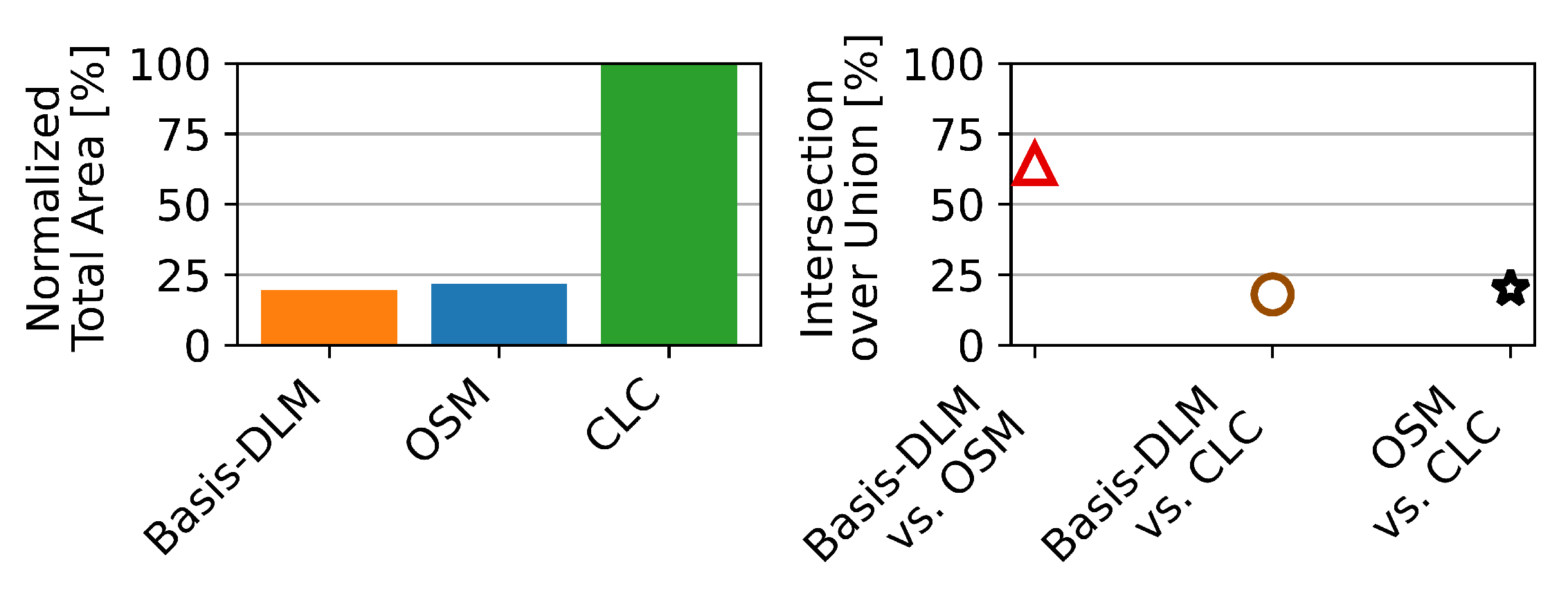
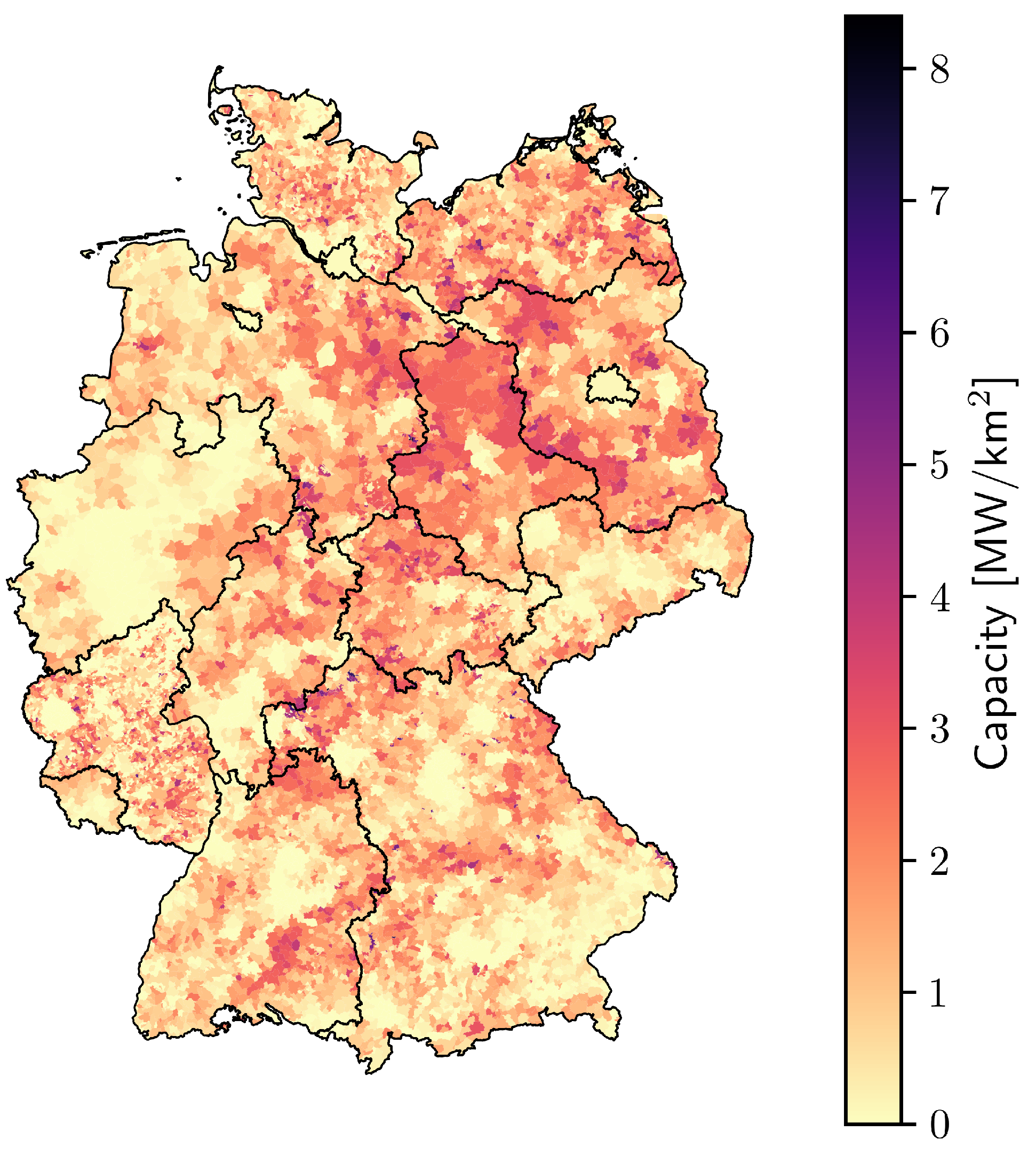



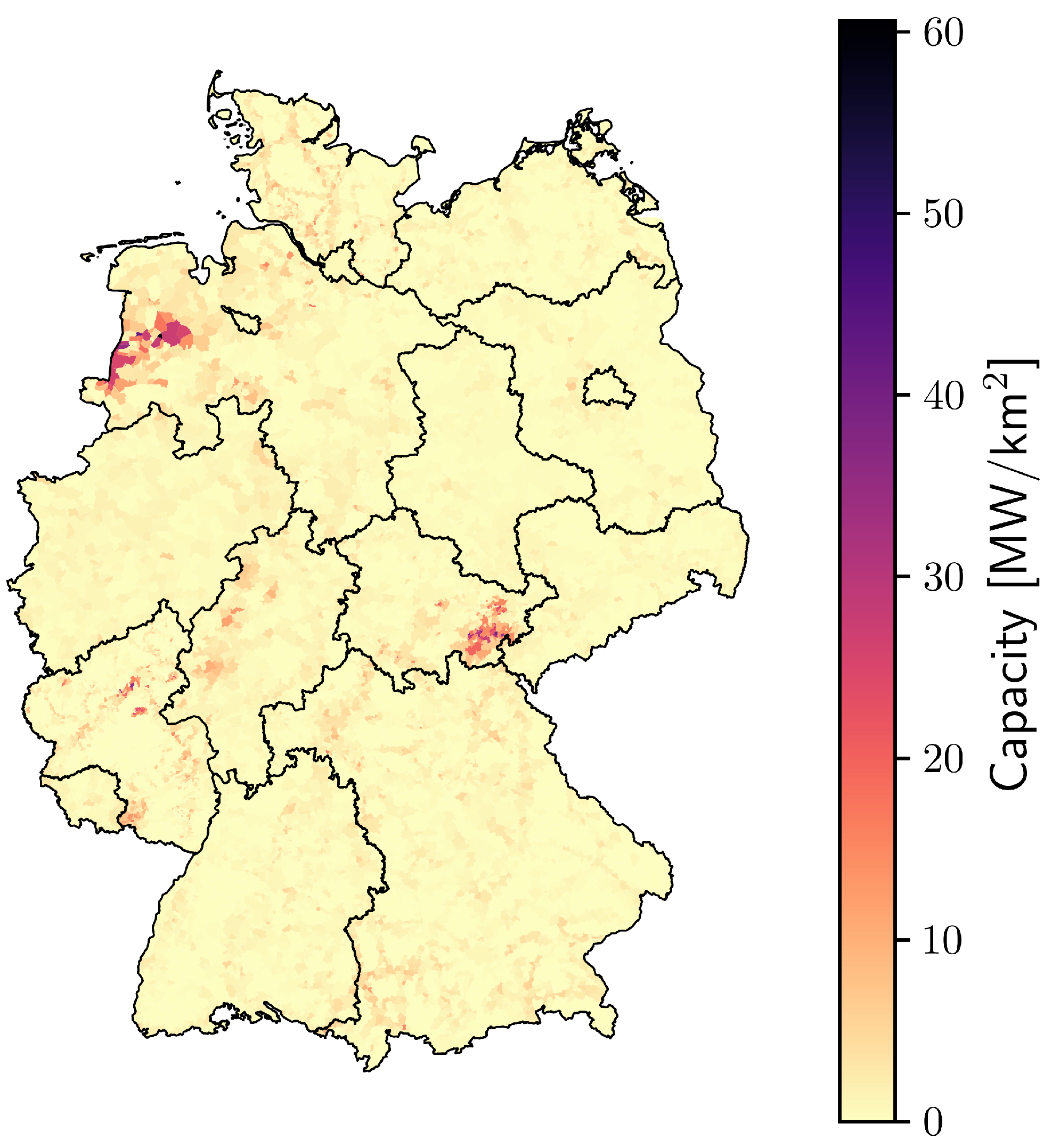

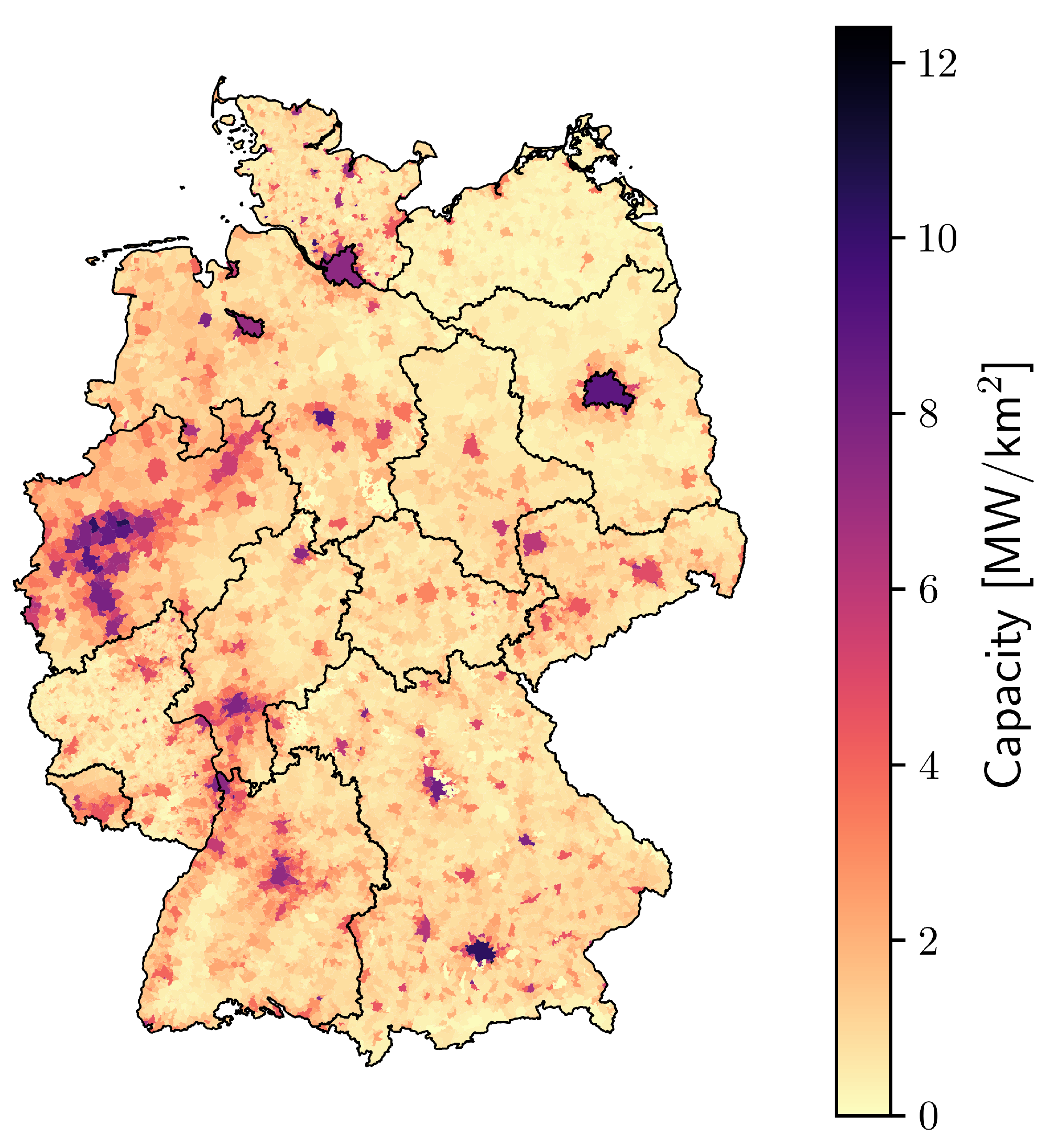
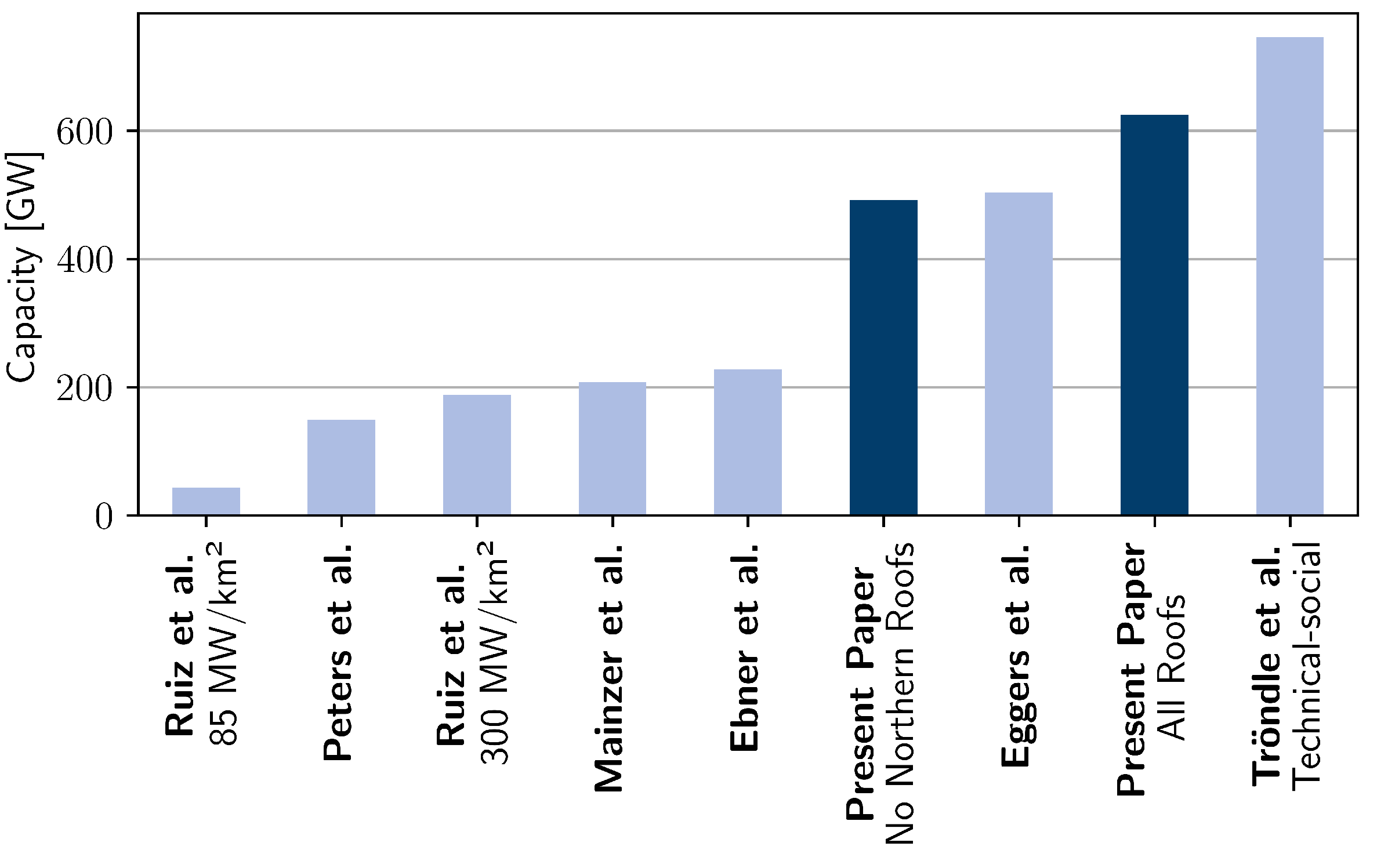
| Criterion | Data Source | S1 1 | S2 2 | S2a 2a | S2b 2b | S3 3 |
|---|---|---|---|---|---|---|
| Inner areas | Basis-DLM [12] | individual * | 1000 | 1000 | 1000 | 1000 |
| Residential buildings, outer areas | Hausumringe [45] | individual * | 3 H | 3 H | 3 H | 1000 |
| Forests | Basis-DLM [12] | individual * | not excluded | not excluded | 0 | 0 |
| Protected Landscapes | WDPA [15] | individual * | not excluded | 0 | not excluded | 0 |
| S1 1 | S2 2 | S2a 2a | S2b 2b | S3 3 | |
|---|---|---|---|---|---|
| Area [] | 24,663 | 25,938 | 17,613 | 10,056 | 3923 |
| Area Share [%] | 6.89 | 7.25 | 4.92 | 2.81 | 1.10 |
| Capacity [] | 385 | 403 | 287 | 241 | 90 |
| Density on eligible areas [] | 15.6 | 15.5 | 16.3 | 23.9 | 22.8 |
| S1 1 | S1a 1a | S2 2 | S3 3 | |
|---|---|---|---|---|
| Area [] | 7353 | 9275 | 5174 | 3182 |
| Area Share [%] | 13.07 | 16.48 | 9.19 | 5.65 |
| Capacity [] | 79.1 | 99.6 | 55.8 | 34.1 |
| Density on eligible areas [] | 10.75 | 10.74 | 10.79 | 10.71 |
| Criterion | Data Source | S1 Side Strips | S2 Poor Soil | S3 Combination |
|---|---|---|---|---|
| Forests | Basis-DLM [12] | 10 | 10 | 10 |
| All Buildings | Hausumringe [45] | 10 | 10 | 10 |
| Arable land | Basis-DLM [12], SQR [76] | not excluded | SQR | SQR , Sidestripes: SQR |
| Motorways, Railways | Basis-DLM [12] | 15 | 200 | 15 |
| S1 1 | S2 2 | S3 3 | |
|---|---|---|---|
| Area [] | 5723 | 1560 | 4373 |
| Area Share [%] | 1.60 | 0.44 | 1.22 |
| Capacity [] | 456.1 | 123.6 | 347.7 |
| No. of Municipalities in Germany | 11,003 | 11,003 | 11,003 |
| ⋯ with pre-selected areas | 5667 | 1892 | 6446 |
| ⋯ with potential | 5253 | 1711 | 5939 |
Publisher’s Note: MDPI stays neutral with regard to jurisdictional claims in published maps and institutional affiliations. |
© 2022 by the authors. Licensee MDPI, Basel, Switzerland. This article is an open access article distributed under the terms and conditions of the Creative Commons Attribution (CC BY) license (https://creativecommons.org/licenses/by/4.0/).
Share and Cite
Risch, S.; Maier, R.; Du, J.; Pflugradt, N.; Stenzel, P.; Kotzur, L.; Stolten, D. Potentials of Renewable Energy Sources in Germany and the Influence of Land Use Datasets. Energies 2022, 15, 5536. https://doi.org/10.3390/en15155536
Risch S, Maier R, Du J, Pflugradt N, Stenzel P, Kotzur L, Stolten D. Potentials of Renewable Energy Sources in Germany and the Influence of Land Use Datasets. Energies. 2022; 15(15):5536. https://doi.org/10.3390/en15155536
Chicago/Turabian StyleRisch, Stanley, Rachel Maier, Junsong Du, Noah Pflugradt, Peter Stenzel, Leander Kotzur, and Detlef Stolten. 2022. "Potentials of Renewable Energy Sources in Germany and the Influence of Land Use Datasets" Energies 15, no. 15: 5536. https://doi.org/10.3390/en15155536
APA StyleRisch, S., Maier, R., Du, J., Pflugradt, N., Stenzel, P., Kotzur, L., & Stolten, D. (2022). Potentials of Renewable Energy Sources in Germany and the Influence of Land Use Datasets. Energies, 15(15), 5536. https://doi.org/10.3390/en15155536






